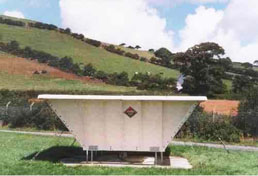Click on image for full size
Courtesy of the Digital Image Library, UCAR
MILAGRO Instruments
Scientists working on the MILAGRO project are using lots of special equipment that they set up on the ground near Mexico City. Here are some examples:Radiosondes: These balloons are similar to the ones that you see at birthday parties but much larger. They rise into the sky with scientific instruments attached to their cords. The instruments measure things like how hot or cold the air is. Also, the scientists can figure out where the wind is blowing and how hard by watching where the balloons go in the sky. During MILAGRO, scientists will launch these balloons near Mexico City.
Tethersonde: A tethersonde is the same idea as the radiosonde, except that the balloon that is attached to the ground with a cord. The cord keeps the balloon from rising high into the sky. It's best for when scientists just want to measure the air near Earth.
Wind profilers: Wind profilers are shaped like big boxes. They measure how fast the wind is blowing and in what direction. The scientists are setting wind profilers up near Mexico City to figure out where the wind blows the air pollution.
Mobile laboratories: These are science labs on wheels! The scientists keep their equipment in vans and trailers that they can drive anywhere to make measurements and do experiments. During the project, they'll be driving the labs around the Mexico City area to test the air for pollution.
Satellites: MILAGRO researchers will also use data retrieved by satellites. Satellites circle Earth from space. They show scientists where air pollution and chemicals are above Earth. One satellite the scientists in Mexico City are using is called MOPITT. MOPITT can take pictures of air pollution in the sky.
Other instruments on airplanes will also be used during the campaign.


















